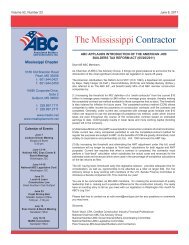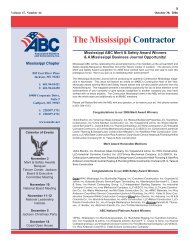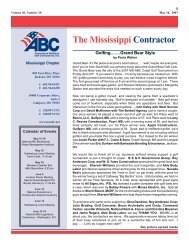§1904.7However, as discussed above, <strong>OSHA</strong> believes thatmore extensive treatment, including the administrationof fluids by intravenous injections (IV), are medicaltreatment, and more serious cases of heat disordersinvolving them must be entered into therecords. In addition, any diagnosis by a physician orother licensed health care professional of heat syncope(fainting due to heat) is recordable under paragraph1904.7(b)(6), Loss of Consciousness.Burns: ...[B]urns will be treated just as other typesof injury are, i.e., minor burn injuries will not berecordable, while more serious burns will be recordedbecause they will involve medical treatment. Forexample, a small second degree burn to the forearmthat is treated with nothing more than a bandage isnot recordable. A larger or more severe seconddegree burn that is treated with prescription creamsor antibiotics, or results in restricted work, job transfer,or days away from work is recordable. The vastmajority of first degree burns and minor seconddegree burns will not be recorded because they willnot meet the recording criteria, including medicaltreatment. However, more serious first and seconddegree burns that receive medical treatment will berecorded, and third degree burns should always berecorded because they require medical treatment….<strong>OSHA</strong> agrees...that certain treatments and interventionsrequire the professional judgment of ahealth care professional. The Agency believes thatthese matters are best left to state agencies andlicensing boards, and the final rule’s definition ofhealth care professional (see Subpart G) makes thisclear….<strong>OSHA</strong>’s reporting requirements do not in any wayinterfere with or have any impact on state workerscompensation reporting requirements. Employersare required to record certain injuries and illnessesunder the <strong>OSHA</strong> recordkeeping regulation and toobserve certain other requirements under workers’compensation law. The two laws have separate functions:workers’ compensation is designed to compensateinjured or ill workers, while the OSH Act isdesigned to prevent injuries and illnesses and to createa body of information to improve understandingof their causes. Thus, certain injuries and illnessesmay be reportable under state workers’ compensationlaw but not under the <strong>OSHA</strong> recordkeeping rule,and certain injuries and illnesses may be reportableunder the <strong>OSHA</strong> rule but not under one or moreworkers’ compensation statutes….In response, <strong>OSHA</strong> notes that the list is part of adefinition that sets mandatory recording and report-ing requirements and is a part of the regulation itself.Including the first aid list as a non-mandatory appendixwould provide additional flexibility for futureupdates, but doing so would not meet the purposesfor which the list is intended. The list is mandatory,and making it non-mandatory would only introduceadditional confusion about what is or is not to beentered into the records….Paragraph 1904.7(b)(6) Loss of ConsciousnessThe final rule, like the former rule, requires theemployer to record any work-related injury or illnessresulting in a loss of consciousness. The recording ofoccupational injuries and illnesses resulting in loss ofconsciousness is clearly required by Sections 8(c)and 24 of the OSH Act. The new rule differs from theformer rule only in clearly applying the loss of consciousnesscriterion to illnesses as well as injuries.Since the former rule required the recording of all illnesses,illnesses involving loss of consciousnesswere recordable, and thus <strong>OSHA</strong> expects that thisclarification will not change recording practices.Thus, any time a worker becomes unconscious as aresult of a workplace exposure to chemicals, heat, anoxygen deficient environment, a blow to the head, orsome other workplace hazard that causes loss of consciousness,the employer must record the case….<strong>OSHA</strong> agrees …that, in order to be a recordableevent, a loss of consciousness must be the result of aworkplace event or exposure. Loss of consciousnessis no different, in this respect, from any other injuryor illness. The exceptions to the presumption ofwork-relationship at Section 1904.5(b)(2)(ii) allow theemployer to exclude cases that “involve signs orsymptoms that surface at work but result solely froma non-work-related event or exposure that occursoutside the work environment.” This exception allowsthe employer to exclude cases where a loss of consciousnessis due solely to a personal health condition,such as epilepsy, diabetes, or narcolepsy….The final rule does not contain an exception forloss of consciousness associated with phobias orfirst aid treatment. <strong>OSHA</strong> notes, however, that theexception at paragraph 1904.5(b)(2)(iii) allows theemployer to rebut the presumption of work relationshipif “the injury or illness results solely from voluntaryparticipation in a wellness program or in a medical,fitness, or recreational activity such as blooddonation, physical, flu shot, exercise class, racquetball,or baseball.” This exception would eliminate therecording of fainting episodes involving voluntaryvaccination programs, blood donations and the like.64<strong>OSHA</strong> RECORDKEEPINGHANDBOOK
However, episodes of fainting from mandatory medicalprocedures such as blood tests mandated by<strong>OSHA</strong> standards, mandatory physicals, and so onwould be considered work-related events, and wouldbe recordable on the Log if they meet one or more ofthe recording criteria. Similarly, a fainting episodeinvolving a phobia stemming from an event or exposurein the work environment would be recordable…....In this final rule, <strong>OSHA</strong> has not included a separatedefinition for the term “loss of consciousness.”However, the language of paragraph 1904.7(b)(6) hasbeen carefully crafted to address two issues. First,the paragraph refers to a worker becoming “unconscious,”which means a complete loss of consciousnessand not a sense of disorientation, “feelingwoozy,” or a other diminished level of awareness.Second, the final rule makes it clear that loss of consciousnessdoes not depend on the amount of timethe employee is unconscious. If the employee is renderedunconscious for any length of time, no matterhow brief, the case must be recorded on the <strong>OSHA</strong>300 Log.Paragraph 1904.7(b)(7) Recording Significant Work-Related Injuries and Illnesses Diagnosed by aPhysician or Other Licensed Health Care ProfessionalParagraph 1904.7(b)(7) of this final rule requires therecording of any significant work-related injury or illnessdiagnosed by a physician or other licensedhealth care professional. Paragraph 1904.7(b)(7) clarifieswhich significant, diagnosed work-related injuriesand illnesses <strong>OSHA</strong> requires the employer to recordin those rare cases where a significant work-relatedinjury or illness has not triggered recording underone or more of the general recording criteria, i.e, hasnot resulted in death, loss of consciousness, medicaltreatment beyond first aid, restricted work or jobtransfer, or days away from work. Based on theAgency’s prior recordkeeping experience, <strong>OSHA</strong>believes that the great majority of significant occupationalinjuries and illnesses will be captured by oneor more of the other general recording criteria inSection 1904.7. However, <strong>OSHA</strong> has found that thereis a limited class of significant work-related injuriesand illnesses that may not be captured under theother Section 1904.7 criteria. Therefore, the final rulestipulates at paragraph 1904.7(b)(7) that any significantwork-related occupational injury or illness that isnot captured by any of the general recording criteriabut is diagnosed by a physician or other licensedhealth care professional be recorded in the employer’srecords.Under the final rule, an injury or illness case isconsidered significant if it is a work-related caseinvolving occupational cancer (e.g., mesothelioma),chronic irreversible disease (e.g., chronic berylliumdisease), a fractured or cracked bone (e.g., brokenarm, cracked rib), or a punctured eardrum. Theemployer must record such cases within 7 days ofreceiving a diagnosis from a physician or otherlicensed health care professional that an injury or illnessof this kind has occurred…....[T]here are some significant injuries, such as apunctured eardrum or a fractured toe or rib, forwhich neither medical treatment nor work restrictionsmay be administered or recommended.There are also a number of significant occupationaldiseases that progress once the disease processbegins or reaches a certain point, such as byssinosis,silicosis, and some types of cancer, for which medicaltreatment or work restrictions may not be recommendedat the time of diagnosis, although medicaltreatment and loss of work certainly will occur atlater stages. This provision of the final rule isdesigned to capture this small group of significantwork-related cases. Although the employer isrequired to record these illnesses even if they manifestthemselves after the employee leaves employment(assuming the illness meets the standards forwork-relatedness that apply to all recordable incidents),these cases are less likely to be recorded oncethe employee has left employment. <strong>OSHA</strong> believesthat work-related cancer, chronic irreversible diseases,fractures of bones or teeth and puncturedeardrums are generally recognized as constitutingsignificant diagnoses and, if the condition is workrelated,are appropriately recorded at the time of initialdiagnosis even if, at that time, medical treatmentor work restrictions are not recommended.As discussed in the Legal Authority section,above, <strong>OSHA</strong> has modified the Agency’s prior positionso that, under the final rule, minor occupationalillnesses no longer are required to be recorded onthe Log. The requirement pertaining to the recordingof all significant diagnosed injuries and illnesses inthis paragraph of the final rule, on the other hand,will ensure that all significant (non-minor) injuriesand illnesses are in fact captured on the Log, asrequired by the OSH Act. Requiring significant casesinvolving diagnosis to be recorded will help toachieve several of the goals of this rulemaking. First,adherence to this requirement will produce betterdata on occupational injury and illness by providingfor more complete recording of significant occupationalconditions. Second, this requirement will producemore timely records because it provides for the§1904.7<strong>OSHA</strong> RECORDKEEPINGHANDBOOK65
- Page 1 and 2:
www.osha.govOSHARecordkeepingHandbo
- Page 3 and 4:
OSHARecordkeeping HandbookThe Regul
- Page 5 and 6:
ContentsRecordkeeping HandbookRoadm
- Page 7 and 8:
Section 1904.40Providing records to
- Page 9 and 10:
Section 1904.0Purpose(66 FR 6122, J
- Page 11 and 12:
Section 1904.1Partial exemption for
- Page 13 and 14:
Section 1904.2Partial exemption for
- Page 15 and 16:
employees, to OSHA within 8 hours (
- Page 17 and 18:
Partial Exemptions for Employers Un
- Page 19 and 20:
Section 1904.4Recording criteria(66
- Page 21 and 22: Section 1904.5Determination of work
- Page 23 and 24: (b)(7) How do I decide if a case is
- Page 25 and 26: well, including providing informati
- Page 27 and 28: This exception, which responds to i
- Page 29 and 30: or she is in the work environment a
- Page 31 and 32: have occurred but for the occupatio
- Page 33 and 34: considered work-related. If an empl
- Page 35 and 36: Question 5-12. Is work-related stre
- Page 37 and 38: • The doctor described the illnes
- Page 39 and 40: Scenario 7:• A site hired numerou
- Page 41 and 42: Letter of interpretation related to
- Page 43 and 44: These principles should be applied
- Page 45 and 46: The problem with the response is tw
- Page 47 and 48: Section 1904.6Determination of new
- Page 49 and 50: the Guidelines stated that “the a
- Page 51 and 52: estricted work. If the case is a pr
- Page 53 and 54: • The doctor also prescribed the
- Page 55 and 56: • The employees were under the di
- Page 57 and 58: Section 1904.7General recording cri
- Page 59 and 60: (iii) Do I have to record restricte
- Page 61 and 62: of the length of time the employee
- Page 63 and 64: then result in days away from work
- Page 65 and 66: A partial day of work is recorded a
- Page 67 and 68: In all other respects, the final ru
- Page 69 and 70: ments. The Agency believes that the
- Page 71: e recorded because it will require
- Page 75 and 76: care professional, he or she may al
- Page 77 and 78: “Other simple means” of removin
- Page 79 and 80: For purposes of OSHA recordkeeping
- Page 81 and 82: • When answering the doctor’s q
- Page 83 and 84: Response: In the recordkeeping regu
- Page 85 and 86: Letter of interpretation related to
- Page 87 and 88: Section 1904.8Recording criteria fo
- Page 89 and 90: caused by contaminated needles and
- Page 91 and 92: Section 1904.9Recording criteria fo
- Page 93 and 94: Section 1904.10Recording criteria f
- Page 95 and 96: hearing loss case that is not relat
- Page 97 and 98: average of 10 decibels or more at 2
- Page 99 and 100: argued that because the function of
- Page 101 and 102: occurs, and where hearing loss can
- Page 103 and 104: cases in their workplace via analys
- Page 105 and 106: March 4, 2004Mr. Carl O. Sall, CIHD
- Page 107 and 108: When the professional evaluating th
- Page 109 and 110: (2) May I line-out or erase a recor
- Page 111 and 112: Section 1904.12Recording criteria f
- Page 113 and 114: These new statistics would add only
- Page 115 and 116: Sections 1904.13 - 1904.28 Reserved
- Page 117 and 118: two lines of the OSHA 300 Log to de
- Page 119 and 120: which replace the OSHA 200 and 101
- Page 121 and 122: different types of occupational ill
- Page 123 and 124:
OSHA 301 form. These data are usefu
- Page 125 and 126:
LETTERS OF INTERPRETATION: Section
- Page 127 and 128:
Question 2: Under 29 CFR Section 19
- Page 129 and 130:
and has adopted language in the fin
- Page 131 and 132:
Section 1904.31Covered employees(66
- Page 133 and 134:
label assigned to a worker is immat
- Page 135 and 136:
These workers should be evaluated j
- Page 137 and 138:
Response: A case is work-related if
- Page 139 and 140:
Response: Section 1904.31 states th
- Page 141 and 142:
Thank you for your interest in occu
- Page 143 and 144:
year covered by the summary. The su
- Page 145 and 146:
2. Number of employees and hours wo
- Page 147 and 148:
LETTERS OF INTERPRETATION: Section
- Page 149 and 150:
Section 1904.33Retention and updati
- Page 151 and 152:
June 23, 2003Mr. Edwin G. Foulke, J
- Page 153 and 154:
Section 1904.34Change in business o
- Page 155 and 156:
PREAMBLE DISCUSSION: Section 1904.3
- Page 157 and 158:
Incident Report (Forms 300 and 301,
- Page 159 and 160:
workers’ compensation claim. See
- Page 161 and 162:
LETTERS OF INTERPRETATION: Section
- Page 163 and 164:
Letter of interpretation related to
- Page 165 and 166:
Question 3: Using the facts in Ques
- Page 167 and 168:
Section 1904.37State recordkeeping
- Page 169 and 170:
tion, require employers to report f
- Page 171 and 172:
(5) If I receive a variance, may th
- Page 173 and 174:
Section 1904.39Reporting fatalities
- Page 175 and 176:
gation. Therefore, the final rule d
- Page 177 and 178:
Section 1904.40Providing records to
- Page 179 and 180:
ness. The government inspector may
- Page 181 and 182:
Response: The controlling employer
- Page 183 and 184:
FREQUENTLY ASKED QUESTIONS: Section
- Page 185 and 186:
OSHA and the BLS have worked togeth
- Page 187 and 188:
provide copies of the retained reco
- Page 189 and 190:
FREQUENTLY ASKED QUESTIONS: Section
- Page 191 and 192:
Section 1904.46Definitions(66 FR 61
- Page 193 and 194:
of business information. For exampl
- Page 195 and 196:
inconvenience associated with keepi
- Page 197 and 198:
skin disease, respiratory disorder,
- Page 199 and 200:
Question 2: Under 29 CFR Section 19
- Page 201:
www.osha.gov







